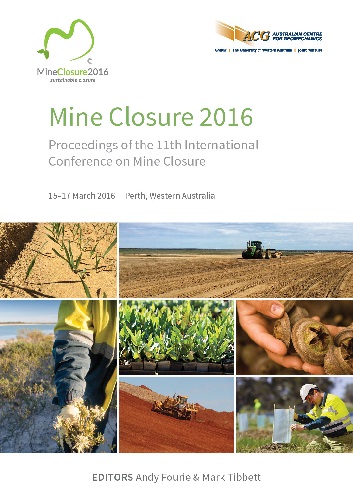The importance of failure in mine closures

|
Authors: von Bismarck, F |
DOI https://doi.org/10.36487/ACG_rep/1608_0.1_von_Bismarck
Cite As:
von Bismarck, F 2016, 'The importance of failure in mine closures', in AB Fourie & M Tibbett (eds), Mine Closure 2016: Proceedings of the 11th International Conference on Mine Closure, Australian Centre for Geomechanics, Perth, pp. 3-12, https://doi.org/10.36487/ACG_rep/1608_0.1_von_Bismarck
Abstract:
When delegates from companies present papers at conferences, the word most frequently cited is success. This is very understandable but an important aspect of being successful is the ability to look honestly at failure. Failure is often stigmatised; rarely is it talked about in the open. The major challenge in mine closure is – and this is something that probably holds true for everybody involved in the process – finding the optimal path that runs between overestimating or underestimating risks. Taking a closer look at failures helps us to find that path. Planners and engineers, even the most well regarded experts and regulators, are human. Their preconceptions may be mistaken, leading them to the wrong conclusions. Sometimes such assumptions are long-standing beliefs, their true worth hidden until failure reveals them to be false. In his famous 1948 work ‘Cybernetics: Or Control and Communication in the Animal and the Machine’, Norbert Wiener laid the foundations for controlling systems and ensuring reliable communication by explaining the essential role of negative feedback in a self-educating system. Mine closure can be considered as such a system. Our attempts to self-educate, such as at international conferences, require negative feedback, or, in other words, an honest assessment of our mistakes. Many success stories could be told about the German Government’s EUR 10 billion, 25-year coal mine rehabilitation programme in the former East Germany. But those involved in the project encountered significant failings, too. In this paper, I present some of those failures in the field of geomechanics and what we have been able to learn from them. For decades, engineers relied on formulas based on established geomechanical models to determine the stability of dumped and levelled waste material. The results of these model calculations were accepted by regulators as no better methods were available. Since 2009, several ground-breaks have proved that these models are incomplete and the process has not yet been fully understood. The long-standing assumption that dumped waste material settles slowly and evenly was evidently untrue. Additionally, the belief that only exogenous forces can trigger a ground-break was found to be false. These mistakened assumptions had severe consequences. As the areas had been deemed stable, the land had already been sold by the mining company and had been in use for several years for activities, including agriculture and forestry. It is truly fortunate that the ground-breaks did not cause any casualties. In the wake of these ground-breaks, all areas of dumped waste were re-evaluated. Access to thousands of hectares of land was barred as a precautionary measure, which in turn delayed the rehabilitation process and necessitated compensation costs for farmers and forest owners. At the same time, more investment became necessary for further research and development (R&D) to come to a better understanding of the process and to develop new and specialised stabilisation measures. This re-evaluation of the waste dumps would pinpoint areas with potential stability deficits, where new technologies such as gentle-blast-compaction have now been applied. These lessons had to be learned the hard way.
References:
Cramer, B, Freytag, K, Voigt, C 2014, ‘Bodenverflüssigungen aus der Sicht der Bergbehörden – Nachweis der Erforderlichkeit und Geeignetheit von Maßnahmen zur Gefahrenabwehr und Anforderungen bei der Entlassung aus der Bergaufsicht’, in W Kudla (ed.), Beiträge zum 2. Kolloquium Bodenverflüssigung bei Kippen des Lausitzer Braunkohlenbergbaus, Freiberg, pp. 11–16.
DeJong, J, Tibbett, M, Fourie, A 2014, Geotechnical systems that evolve with ecological processes, Springer-Verlag (online), Berlin.
Erler, R, Keßler, J, Reinhardt, K 2012, ‘Schonende Sprengverdichtung bei zur Verflüssigung neigenden Lausitzer Sanden’, in W Kudla (ed.), Beiträge zum Fachkolloquium Bodenverflüssigung bei Kippen des Lausitzer Braunkohlenbergbaus, Freiberg,
pp. 244—258.
Kudla, A, Rosenzweig, T, Szczyrba, S 2014, ‘Zusammenfassung der Erkenntnisse aus den laufenden Forschungsarbeiten und Übertragung auf die Innenkippen’, in W Kudla (ed.), Beiträge zum 2. Kolloquium Bodenverflüssigung bei Kippen des Lausitzer Braunkohlenbergbaus, Freiberg, pp. 117–136.
Kuyumcu, M & Zschiedrich, K 2012, ‘Neue Herausforderungen bei der geotechnischen Sicherung von Innenkippen in der Lausitz sowie Ansätze zu deren Bewältigung durch die LMBV’, in W Kudla (ed.), Beiträge zum Fachkolloquium Bodenverflüssigung bei Kippen des Lausitzer Braunkohlenbergbaus, Freiberg, pp. 6–15.
Scholz, E 2014, ‘Entwicklung neuer Sanierungstechnologien und mittelfristige Strategie zur Sicherung der Innenkippenflächen der Lausitz’, in W Kudla (ed.), Beiträge zum 2. Kolloquium Bodenverflüssigung bei Kippen des Lausitzer Braunkohlenbergbaus, Freiberg, pp. 1–10.
von Bismarck, F 2012, ‘20 Jahre Verwaltungsabkommen – Gesichter und Geschichten der Braunkohlesanierung’ (ed.), Berlin, p. 7.
Weißbach, J & Kudla, W 2012, ‘Auswertung und Erkenntnisse aus den bisherigen Schadensfällen aufgrund von Verflüssigungen bei Innenkippen in der Lausitz’, in W Kudla (ed.), Beiträge zum Fachkolloquium Bodenverflüssigung bei Kippen des Lausitzer Braunkohlenbergbaus, Freiberg, pp. 25–39.
Wiener, N 1948, ‘Cybernetics: Or Control and Communication in the Animal and the Machine’, (ed.), Cambridge, Massachusetts (MIT Press).
© Copyright 2025, Australian Centre for Geomechanics (ACG), The University of Western Australia. All rights reserved.
View copyright/legal information
Please direct any queries or error reports to repository-acg@uwa.edu.au
View copyright/legal information
Please direct any queries or error reports to repository-acg@uwa.edu.au